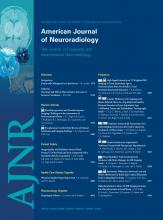Abstract
BACKGROUND AND PURPOSE: CTA provides high-resolution imaging of the head and neck vasculature but also of the soft tissues and bones. This results in a large volume of information to be interpreted. This study examines interpretation errors with head and neck CTAs and assesses whether double reading reduces miss rates.
MATERIALS AND METHODS: Consecutive CTAs of the neck and intracranial circulation were retrospectively identified and reviewed for vascular and nonvascular findings by a consensus of 2 neuroradiologists. The results were compared with the official report. Significant discrepancies were considered those that would have influenced follow-up or management.
RESULTS: We reviewed 503 studies; 144 were originally reported by a staff neuroradiologist alone, 209 by staff and diagnostic radiology resident, and 150 by staff and neuroradiology fellow. Twenty-six significant discrepancies were discovered in 20 studies, corresponding to 4.0% of studies with at least 1 miss, and an overall miss rate per study of 5.2%. There was at least 1 miss in 6.3% of studies interpreted by a staff neuroradiologist alone, 3.3% by staff and resident, and 2.7% by staff and fellow. The miss rate differences were not statistically significant. The most common misses were small aneurysms (50% of misses).
CONCLUSIONS: CTA neck and head datasets are now large, and there is a potential for missed findings. Significant discrepancies can occur with a low but not insignificant rate. Arterial pathology accounted for most discrepancies. This study emphasizes the need for careful systematic scrutiny for both vascular and nonvascular pathology regardless of indication. Double reading reduces error rates.
ABBREVIATIONS
- CTA
- CT angiography
- MPR
- multiplanar reformatted
- © 2011 by American Journal of Neuroradiology







